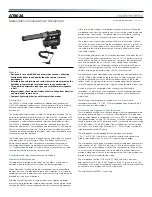
broadcast & production
microphones
AT8024
Stereo/Mono Camera-Mount Microphone
Features
• Designed for use with DSLR and other video cameras, delivering
dramatically better sound quality than the camera’s internal
microphone
• Selectable line-cardioid mono or mid-side stereo modes provide the
flexibility to capture high-resolution audio in any environment
• Three-position adjustable input pad and switchable low-frequency
roll-off
• Integral rubber shock mounts isolate the microphone from vibration
and mechanical camera noise
• Compact, lightweight design with integral shoe mount
Description
The AT8024 is a fixed-charge condenser microphone designed for use
with DSLR and other video cameras. The microphone offers the flexibility
of mono and mid-side stereo modes for high-resolution audio in any
environment.
The microphone is powered by a single 1.5V AA battery, included. The AA
battery provides optimal performance with high max SPL. A red/green LED
power indicator, located on the top of the unit, illuminates green when the
microphone is sufficiently powered and red when battery power is low.
The AT8024 is equipped with a three-position input pad that allows for
attenuation adjustment. The microphone also features an 80 Hz high-pass
filter switch that permits choice of flat response or low-frequency roll-off
to reduce the pickup of undesired ambient noise, room reverberation and
mechanically coupled vibrations.
The microphone is enclosed in a rugged housing and includes an integral
shoe mount that fits most camera shoes. Two rubber shock mounts
isolate the microphone from vibration and mechanical camera noise.
The microphone includes a permanently attached cable with a 3.5 mm
(
1
/
8
") L-type stereo plug output. A clip on the shoe mount holds the cable,
relieving tension and preventing vibration noise.
A windscreen and fuzzy windscreen are also included.
Operation & Maintenance
The mode switch located on the top of the unit allows user to select
between mono and internally matrixed mid-side stereo modes.
Mono Operation: In Mono mode, the microphone uses its line-cardioid
element exclusively to provide excellent off-axis rejection. This is ideal for
recording interviews, dialogues or sound sources that might otherwise be
drowned out in noisy environments.
Mid-Side Stereo Operation: In Stereo mode, the microphone provides
internally matrixed mid-side stereo, delivering wide, life-like stereo sound.
Locating the AT8024 nearer the sound source will enhance the apparent
width of the stereo image, while decreasing room ambience. Moving the
microphone away from the sound source will narrow the stereo image and
provide more “room sound.” The Stereo mode is well-suited for sporting
events and other active situations where sonic realism is desired.
The integral shoe mount slides into the shoe of most cameras. Tighten
the nut on the shoe mount to hold the microphone securely in place. The
shoe mount is also equipped with a strain-relief clip for the cable. Insert
the cable into the clip to reduce wear on the cable and eliminate noise
from cable vibration.
To install the battery, press the PUSH button located on the side of the unit.
This will eject the battery compartment. Insert a 1.5V AA battery according
to the polarity markings in the compartment, then press the compartment
back into the body of the unit so that it clicks closed. When the mode
switch is moved from the Off position to Mono or Stereo, the LED power
indicator will illuminate green, showing that the microphone has power.
Replace or recharge the battery when the LED illuminates red.
The attenuation can be adjusted by using the three-position input pad switch
(-20 dB, -10 dB, 0 dB) located on the top of the unit. Adjust according to the
volume of the sound source: -20 dB for the loudest sounds, 0 dB for the
softest. The 80 Hz high-pass filter switch is located alongside the input pad
switch. To engage the high-pass filter, slide the switch toward the “bent” line.
Since even slight or unexpected winds can adversely affect audio
recordings, it is best to use the microphone with the supplied windscreen
or, when recording in especially windy environments, the supplied fuzzy
windscreen.
Avoid leaving the microphone in the open sun or in areas where
temperatures exceed 110° F (43° C) for extended periods. Extremely high
humidity should also be avoided.
Architect’s and Engineer’s Specifications
The microphone shall be a mini shotgun design with two independent fixed
charge condenser elements. It shall have line-cardioid and LR stereo polar
patterns and a frequency response of 40 Hz to 15,000 Hz. The microphone
shall be powered by a single 1.5V AA battery. It shall be capable of handling
sound input levels up to 128 dB (mono and LR stereo) with a dynamic range
of 106 dB (mono), 104 dB (LR stereo). Nominal open circuit output voltage
shall be 14.1 mV (mono and LR stereo) at 1V, 1 Pascal. Output shall be low
impedance unbalanced (50 ohms).
The microphone shall be equipped with a permanently attached
0.2 m -1 m (7.8"-39.3") cable that is straight at the ends and coiled in the
middle, terminated with a 3.5 mm (
1
/
8
") L-type stereo plug output.
The microphone shall include a three-position adjustable input pad to select
attenuation of -20 dB, -10 dB or 0 dB, and a switch to permit choice of flat
response or 80 Hz low-frequency roll-off. The microphone shall also include
switch selection of Mono mode and Stereo mode. The Mono mode shall
provide a mono signal from its line-cardioid element. The Stereo mode shall
provide internally matrixed mid-side stereo.
The microphone shall be 172.0 mm (6.77") long and have a maximum
body diameter of 24.0 mm (0.94"). Weight shall be 114 grams (4.0 oz). The
microphone shall include an integrated shoe mount with a tension-relief clip
for the cable, a windscreen and a fuzzy windscreen.
The Audio-Technica AT8024 is specified.


